Blog 23-1 January 2, 2023, Written by Jerry Elman
Happy New Year!
After taking some time off, I redesigned my website and blog and conducted new research focused on the death camps. I have learned so much that I never knew about the Nazi death camps and how they evolved. This is all information even my parents never knew. I am now sharing that information with you.
The facts are so unbelievable and horrifying, yet absolutely true. The death camps were engineered and built to be massive killing factories no different than any other industrial or manufacturing plant. They were huge complexes built by human beings to murder other human beings in the cruelest high-volume industrialized manner.
As I wrote this article, I could not stop thinking about the members of my family that were transported to Nazi death camps and perished. I know my father’s family members went to Auschwitz-Birkenau, and my mother’s family members went to Treblinka II. I was at Auschwitz-Birkenau in April 2022. I stood at the same train arrival area they entered the camp in. The same area they went through the selection process. Did they go straight to the gas chambers, or were some selected for work? Where are their ashes? My fellow second-generation survivors all wonder the same things. Like the closure our surviving parents never had, we, too, have no closure to the fate of our family members who perished.
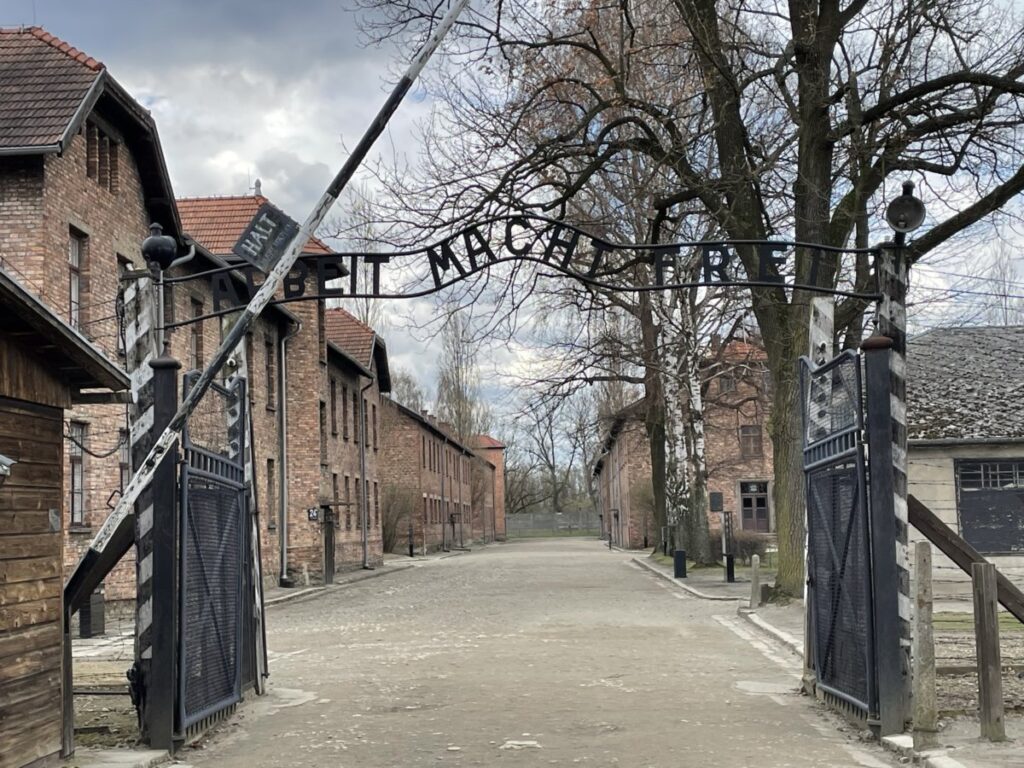
Main Gate of Auschwitz 1 Concentration Camp.
Picture was taken by me in April 2022
As schoolchildren, we all learned about the Industrial Revolution and the benefits resulting from new technology, mechanization of production processes, and maximization of profit.
Productivity and efficiency grew at a historically unprecedented rate as more goods and services could be produced more rapidly and at a lower cost than ever before.
Unfortunately, such innovations can be implemented for evil as well as for good.
The Nazis created an Industrial Revolution of mass killing. The entire government of Germany, together with German industry, created large-scale factories that killed people in unimaginable numbers.
Even more sickening was the profits this mass-killing industry generated.
Types of Nazi Camps
It is important to understand the terminology and various definitions of Nazi camps. Even I did not understand the differences.
Ghettos were areas of Jewish cities and towns where Jews were forced to live once under Nazi occupation. Within the Ghettos, Jews were self-governed as long as they met Nazi demands.
Concentration Camps were the primary work and slave labor camps. Jews were housed within these camps in barracks to be used as slave labor. They were killed through starvation, exhaustion, and disease. Most people interchanged Concentration Camps and Extermination/Death Camps as the same thing. They were not. Examples of some of the concentration camps are Bergen-Belson, Buchenwald, Dachau, and many more.
Extermination or Death Camps were camps built solely for the purpose of killing people in large numbers. People were transported to these camps and sent from the arriving trains directly to the gas chambers and crematoriums. There was no need for barracks or places to work. These were the “death factories.”
Auschwitz-Birkenau was unique because it was both a massive Concentration Camp and Death Camp. When the trains arrived, there was a selection process. Prisoners were selected for work and then went to the barracks. The bulk of the arriving prisoners were sent directly to the gas chambers. A small number were selected for medical experiments and torture before being killed.
The Plan to Exterminate the Jews Evolved
When Hitler came to power in 1933, he did not yet know that he would develop a plan to kill all the Jews in Europe.
In 1933, Hitler only took control of Germany. There were about 525,000 Jews in Germany at that time.
Hitler’s plan was to force all 525,000 Jews to leave Germany. That would be achieved by taking the rights of Jews away, seizing their property, and making daily life as miserable as possible. From 1933 to 1938, Hilter’s focus was to force the Jews to leave Germany on their own.
One of the obstacles to this plan was the refusal by most other nations to allow Jews to immigrate to their countries. This has been covered in past blogs.
About 304,000 Jews did successfully leave Germany over five years. Many, like Otto Frank and his family, went to the Netherlands. Many went to France and other Western European countries.
This immigration effort to other European countries would only be temporary. After the start of WW II, Hitler occupied these countries, and all the Jews living in them became under Hitler’s control. Those who immigrated to these countries had only gained time. Anne Frank’s story is one example of tens of thousands who faced the same fate. Her family fled Germany for Amsterdam, which fell under Nazi control two years later.
When Hitler annexed Austria in 1938, an additional 191,000 Jews fell under Hitler’s control. Next was the annexation of Czechoslovakia which added another 357,000 Jews.
Poland had 3.1 Million Jews. With the peace treaty signed by Hitler and Stalin, Poland was split between the two countries, with the rest of eastern Europe going to Russia. This added about one-half of the Polish Jews under Hitler’s control, about 1.5 million.
Invading France, the Netherlands, Belgium, and other western European countries added an additional 500,000 Jews under Hitler’s control. This was about 2.6 million Jews in total.
Forcing them to leave was no longer a solution. First, there was no practical way to force those numbers of people to leave.
Second, there was nowhere for them to go. Hitler occupied most of Western Europe. Stalin would not allow Jews into Russia and the other countries he controlled. Britain, America, and most of the rest of the world would not allow large numbers of Jews into their countries.
But killing this number of people required new tactics to kill them quickly in such large numbers.
It started with firing squads where Jews were rounded up in groups and shot to death. The bodies were then buried in large pits.

German firing squad

Jewish women about to be shot by a firing squad in an unknown Ghetto
The use of firing squads was too visible to the population. German soldiers were not comfortable performing such mass killings so morale was impacted. A high volume of guns and ammunition had to be diverted from the war effort. And finally, the number of Jews killed was still relatively small compared to the total population.
Gassing Squads
Hilter next created mobile gassing squads called “Einsatzgruppen,” staffed solely by SS officers. SS officers were the most loyal and dedicated to Hitler and the Nazi cause. They were also the most brutal.
These gassing squads traveled to the newly created Jewish Ghettos with hermetically sealed trucks where engine exhaust was diverted to the interior compartment. Jews would be loaded onto these trucks and subjected to CO2 poisoning from the exhaust fumes. It took about 20 minutes to kill each group. Large pits were dug by Jewish prisoners to bury the bodies.
This created a faster, more efficient way to kill Jews without involving mainstream German soldiers. The killing was also out of the sight of the local population. Between 1.5 and 2 million Jews were killed in 1941 and 1942 using these gassing squads.

Gassing Truck

Destroyed gassing truck at the end of the war

Mass grave pits were dug to dispose of victims killed by firing or gassing squads.
The Invasion of Russia Creates the “Final Solution”
In June 1941, Germany invaded Russia and quickly took over the rest of Poland and all of eastern Europe. This added an additional 5 million Jews under Hitler’s control. The total was now about 9.5 million Jews.
Hilter and the Nazis wanted a faster, more efficient way to kill this number of Jews. The “Final Solution” (Nazi term for the extermination of all Jews) was decided in January 1942 at the Wannsee Conference.
High-ranking officials from the Nazi party, the SS, the German government, and industrial leaders met to coordinate and finalize what they referred to as the “final solution” to the Jewish problem.” The order was to kill every Jew who lived in Nazi-controlled territory. None were to survive! The eradication of the Jews was to be completed within two years.
It was also decided that the SS would be responsible for carrying out the killing program and that all the Jews of Europe would be deported primarily to death camp facilities built in occupied Poland and killed there. Poland had the largest Jewish population. Poland connected with all the rail hubs of Eastern and Western Europe, and the Polish people, for the most part, supported and assisted with the elimination of Jews.
The Nazis did not want this scale of killing to take place in Germany. They always worried that exposing so much killing to German soldiers and the German population would not be tolerated and would create a backlash.
The plan was to implement state-of-the-art industrial methods to kill Jews in large numbers with minimum resources. German industry engineered the killing “factories.” German government agencies created the plan and provided the administrative structure to exterminate Jews as a higher priority than the German war effort. Hitler and German leadership decided that even if Germany were to lose the war, they would still achieve the eradication of Jews.
Nazi Germany now became a genocidal-focused state. The first and only of its kind!
The policy of Jewish extermination involved every level of German society and marshaled the entire apparatus of the German government and private industry just as the war effort did.
The location and operation of the camps were based on calculations of accessibility and cost-effectiveness — the hallmarks of modern business and administrative practice.
Six death camps were built in Poland. They were Auschwitz II-Birkenau, Belzek, Chelmno, Majdanek, Sobibor and Treblinka. Auschwitz II-Birkenau became the largest and most notorious of the six killing centers.
The killing was performed systematically under the supervision of government agencies and bureaucrats together with German industrial giants. Death camps were built like factories. They were located close to major railroad connections for efficient transport and collection of the largest numbers of Jews.
The critical mass-killing process elements were the transportation of victims, the killing process, the “get rid of the bodies” process and monetizing the entire operation process.

Jewish population by country – 1942

Actual Document Created at the Wannsee Conference Counting Jews to be Killed By Country – Total was 11 Million! Not all these countries fell under Nazi control.
The Nazis would control about 9.5 Million Jews and kill over 6 Million!

Close-up view of the above document

Map of killing centers and transit paths. Auschwitz-Birkenau was strategically located and built to conduct the bulk of the killing.
Transportation
Hitler’s plan for the “Final Solution” relied on careful mobilization and scheduling to efficiently shuttle millions of victims, often whole Jewish communities, across the European railway network in train cattle cars to the death camps, where victims were rapidly murdered. Jews were already forced to live in Ghettos which made it easy to gather them up and transport them to the death camps. Most Ghettos were in major cities with direct access to the railroad system.
The complex logistics of this effort were solved through the involvement of the Deutsche Reichsbahn (German National Railway).
Reichsbahn employed almost half a million civil servants and 900,000 workers, who were made available for the effort, and knowingly participated in the killings. The Reichsbahn shuttled victims in “special trains” that kept to a well-formulated time schedule. It has been argued that the IBM Corporation also participated in helping to ensure that Hitler’s special trains ran on time and provided a punch card system to help achieve this goal.
Although the prisoner trains took away valuable railroad capacity needed for the military and the war effort, the prisoner transport effort was the higher priority. The train system allowed for the mass scale and shortened duration over which the extermination needed to take place. The fully enclosed nature of the locked and windowless cattle wagons significantly reduced the number and skill of troops required to transport the condemned Jews to their destinations. The use of railroads enabled the Nazis to lie about the “resettlement program.” The large volume of prisoners transported forced building and operating larger and more efficient gassing facilities, which also required limited supervision because of the scale.

Jew boarding train for death camp
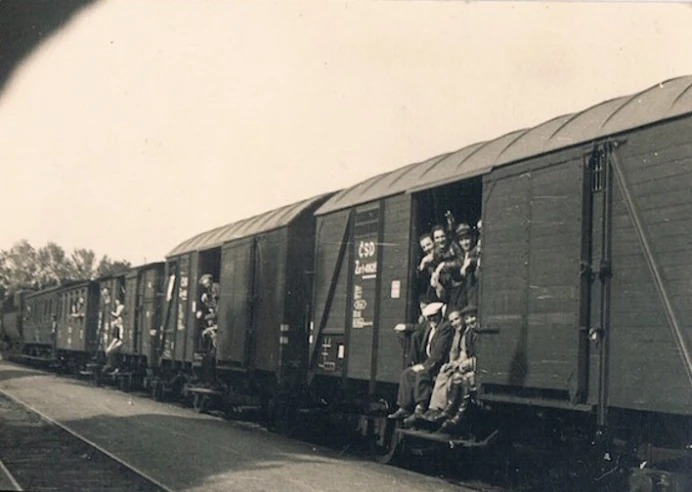
Full train, people we squeezed as tight as possible. No food or water was provided. Only one bucket was provided as a toilet.
Killing
In March 1942, Hitler was unhappy with the slow pace of Jewish extermination. The problem was that the infrastructure to kill large numbers of Jews was not yet in place. The methods and processes were not yet figured out. Under Hitler’s orders, the first phase of implementing the Final Solution was initiated under the codename “Operation Reinhard,” which took place between August to October 1942.
The scope of Operation Reinhard was to exterminate all the Polish Jews in the German-annexed area of Poland by year-end 1942. This area was called “The General Government” and consisted of the districts of Warsaw, Cracow, Lublin, Radom, and Lviv. This area contained Jewish Ghettos inhabited by approximately 2.3 million Jews. The Belzec, Sobibor, and Treblinka I death camps were quickly built as temporary death camps for Operation Reinhard. These sites were picked because they were close to the Jewish population to be exterminated.
These death camps were built in isolated areas. The gas chambers were primitive, using carbon monoxide gas, and there were no crematoriums. Dead bodies were thrown into immense mass graves and covered with lime. The killing capacity reached 12,000 per 24-hour day. About 1.7 million Jews were killed, and the operation was halted because handling the volume of dead bodies was overwhelming. The three temporary death camps were closed. The operation was viewed as a success by the Nazis and confirmed high volume mass extermination could be accomplished. Twenty-five percent of all the Jews murdered in the Holocaust were killed in these three months. This was the deadliest three months in human history.
But at the same time, there was a major problem. The dead bodies were rotting, creating an immense stench and disease hazard in the areas surrounding the three death camps. The population living in these areas figured out this was all from mass graves and demanded action. The Nazis ended up bulldozing the corpses and burning the bodies in massive burning pits. The Nazis decided they had to come up with a high-volume incineration process to dispose of the corpses. Designing and building new death camps with optimal gas chambers and crematoriums to exterminate all remaining Jews to meet the original two-year schedule became the focus. Four new extermination camps were built. Auschwitz II-Birkenau, Chelmno, Majdanek, and Treblinka II. Auschwitz-Birkenau and Majdanek were built as combined concentration/labor and death camps. That required living barracks and industrial infrastructure in addition to what a death camp required. The other camps were entirely death camps, so no barracks or industries for slave labor were needed.
Auschwitz Becomes The Primary Combined Concentration and Death Camp
Auschwitz opened as a detention camp for political prisoners in 1940. It was a complex of brick buildings built during WW I as barracks for the Polish Army. The camp housed prisoners and contained the commandant’s headquarters, the main administrative offices for the entire camp, the central warehouses, and the first “old” funeral home-type crematorium (four ovens). There were also two small gas chambers, which operated from the fall of 1941 to the fall of 1942. Experimentation with Zyklon B gas and cremation of corpses took place in these small-volume gas chambers and ovens.
The implementation of the Final Solution resulted in Auschwitz being selected as the primary combined concentration (work/labor) and death camp for all European Jews. Auschwitz was located at an existing railway junction that had 44 parallel tracks that connected with all of western and eastern Europe. This rail infrastructure could handle moving the millions of Jews without much expansion or investment.
Auschwitz had a massive amount of available land to build the enormous number of barracks required for slave labor prisoners and the mass killing infrastructure. The infrastructure for the administration of this massive operation was already in place within the original camp.
The experimentation with Zyklon B gas proved to be a success. High-volume incinerators were built and tested for the disposal of dead bodies.
Orders were given to quickly build the Auschwitz II camp, named Birkenau, next to the existing camp, which received the name Auschwitz I.
Auschwitz II-Birkenau covered over 500 acres and contained prisoner barracks, gas chambers, four crematoria with a daily throughput calculated by Nazi officials at 4,500 corpses per 24-hour day, and a complex of 30 warehouses for the personal belongings confiscated from the victims.
Sub-camps, including Auschwitz III, were built throughout the Upper Silesian Industrial Region, where Auschwitz was located. The 150,000 Auschwitz-Birkenau prisoners housed in these subcamps performed slave labor, mostly in German coal mines, mills, armaments plants, and at the large building sites for new industrial facilities of importance to the German war economy. When the prisoners had been worked to exhaustion, they were sent back to Auschwitz-Birkenau, killed, and replaced. The average life span of these workers was nine months.
The transportation of Jews to Auschwitz-Birkenau exceeded planning estimates. While the gas chambers could accommodate the increased numbers, the crematorium could not. Workers pushed the incinerators to their limits, with a daily average of 6,000 corpses per 24 hours day and peak times of 9,000 corpses. The incinerators were not designed for this volume and broke down on a regular basis. It was decided that fewer corpses would be incinerated in the crematoriums, and outdoor open burning pits were added to keep up with the volume of corpses.
It should be noted that only nuclear weapons can kill at a greater capacity than the Nazi death camps.
Human Ash Disposal
Given the number of corpses incinerated, enormous amounts of human ashes had to be disposed of. After the corpses were incinerated in the crematorium, prisoners used wooden mallets to crush any remaining bones into powder.
Everything was then loaded onto trucks and carried to the banks of the Vistula river, beyond the woods in Birkenau, where it was shoveled straight into the waters of the river.
Human ashes were also dumped into the Soła river near the Auschwitz I camp and into holes and depressions in the terrain.
Human ashes were used as a base in asphalt for building roads, as a binder for reinforcing dikes, and as an additive to the compost/fertilizer used on the camp farms.
Significant deposits of human ashes were also buried in large pits dug into vacant land surrounding the camp. These pits have formed into ponds over time.

Auschwitz was comprised of three primary camps. Auschwitz 1 was the original camp built with two small gas chambers and one crematorium. This is where what is known as the Auschwitz “main gate is located. The rest of Auschwitz 1 was used as administrative buildings and prisoner quarters. Auschwitz 1 survived intact for the most part because the Germans did not destroy it, and most buildings were built with brick, so it has held up over time.
Auschwitz 2 is Birkenau, where over 90% of the killing took place. Crematoriums 2, 3, 4, and 5 were built here. Each crematorium had associated gas chambers.
Auschwitz 3 was a concentration/labor camp and industrial site. I.G. Farben was a German chemical conglomerate that manufactured Zyklon B gas and designed and built gas chambers for the death camps.
The plant at Auschwitz 3 shown on the map was a synthetic rubber plant where Jewish prisoners worked as slave labor.
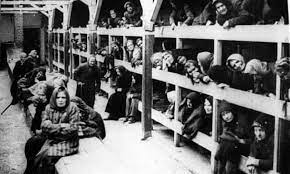
Work barracks date unknown. Each barracks building housed about 1,000 prisoners, eight to a bunk.
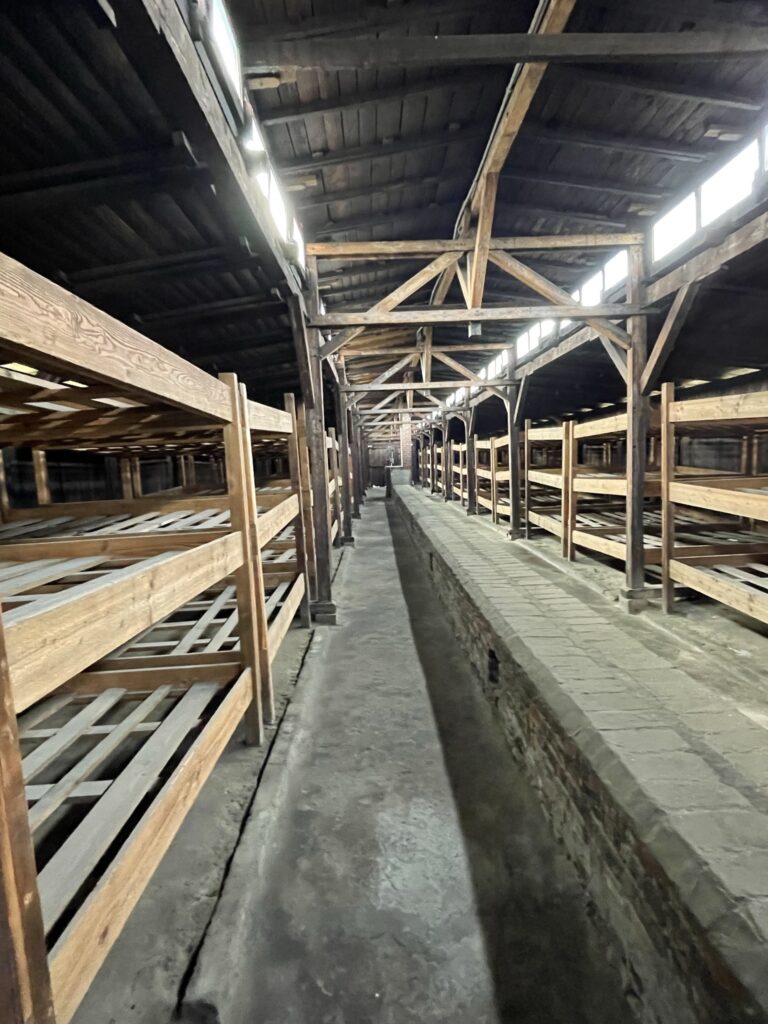
Work barracks as they appear today.

Surveillance aerial view of the Birkenau camp taken by an allied airplane in 1944. None of the Nazi death camps were ever bombed. None of the rail lines were bombed. Even the chemical plant that made Zyklon B was not bombed. Yet all these sites have recorded aerial surveillance.
Auschwitz 3 was bombed because it produced German war effort materials.
The killing of Jews was not considered a priority to stop for the allies.
The Arrival and Selection Train Yard
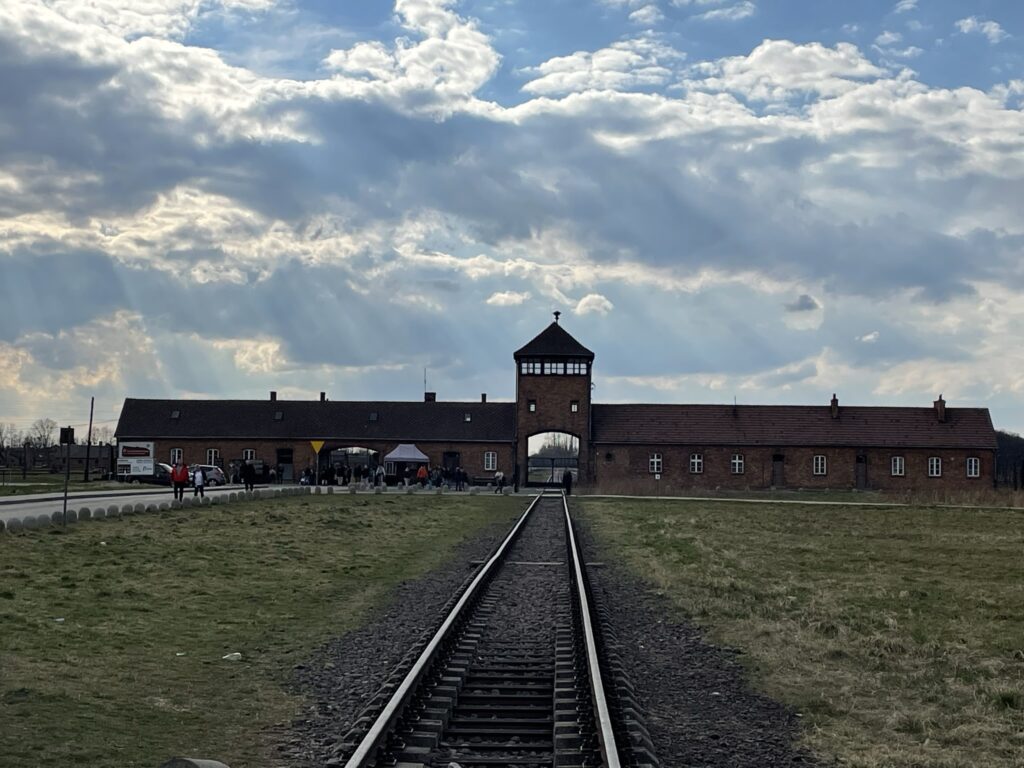
Infamous arrival building of Birkenau. Trains passed through this arch and unloaded prisoners in the train yard behind the building.
At the peak, there were forty-four main train routes feeding Birkenau, with trains arriving non-stop.
Picture was taken by me in April 2022
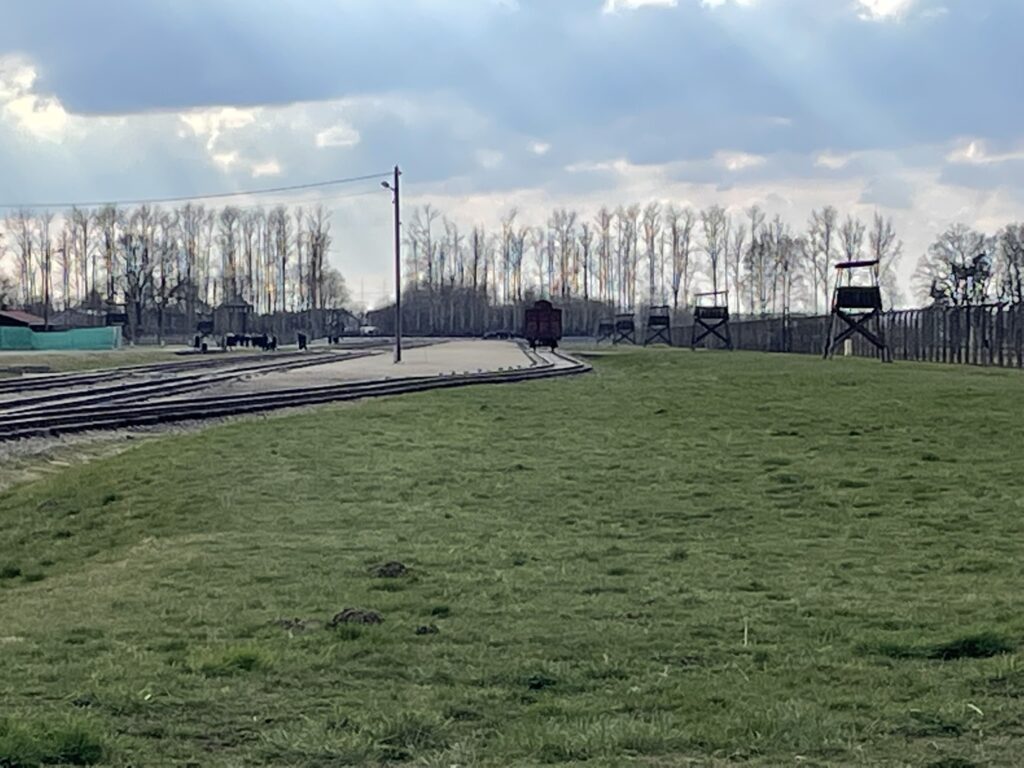
Train arrival yard behind arrival building as it looks today.
Picture was taken by me in April 2022

Men, women, and children are sorted upon arrival in the same arrival yard as above. Most would be escorted straight to the gas chambers.

Upclose view of women and children being lined up after arrival. This picture brought tears to my eyes, knowing they were headed for the gas chambers. The expression on their faces says it all.

Another view with women and men now in separate selection lines before they are escorted to the gas chambers
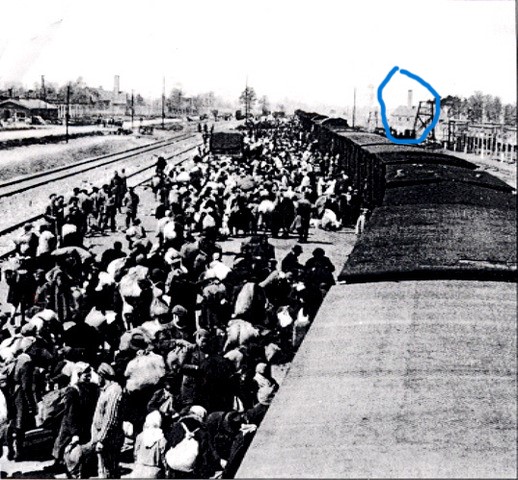
A different train arrival. People are being lined up. The circled building and chimney in the back right is crematorium 6. On the opposite left is crematorium 5.

Line of women and children walking to what they think are the “showers.” The reality was they were walking to a gas chamber and would soon be dead.
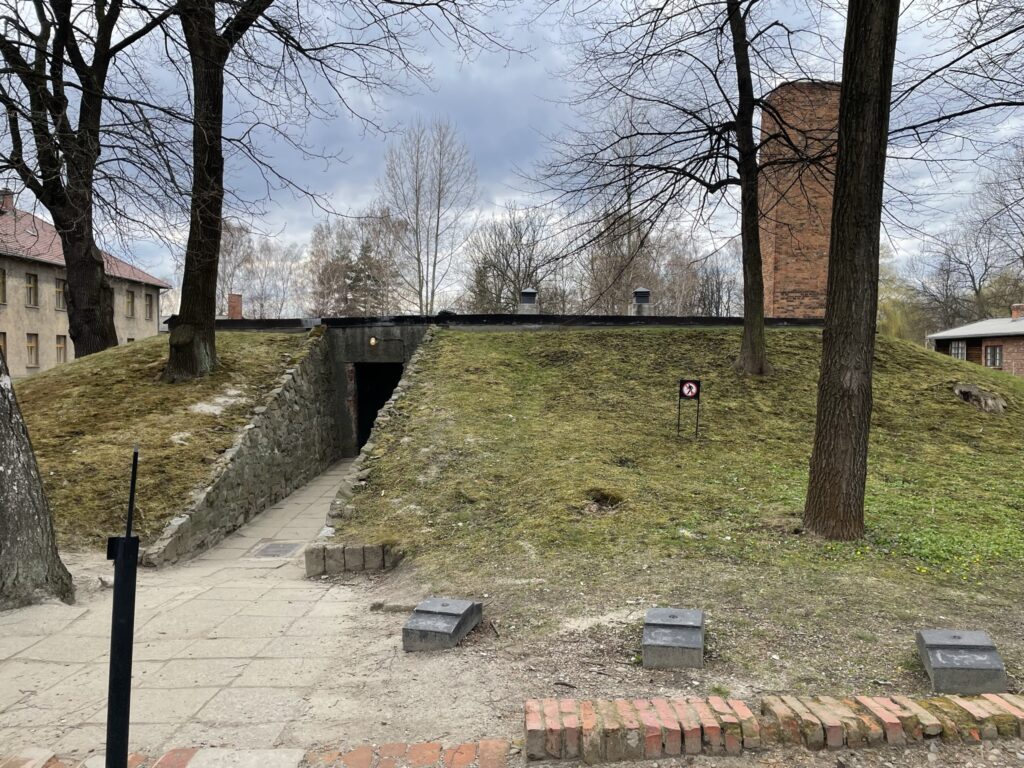
The exterior of Auschwitz 2 gas chamber. This was one of the smallest gas chambers built. It is the only gas chamber that was not destroyed at Auschwitz-Birkenau.
Picture was taken by me in April 2022.

Inside Auschwitz 2 gas chamber.
Picture was taken by me in April 2022.
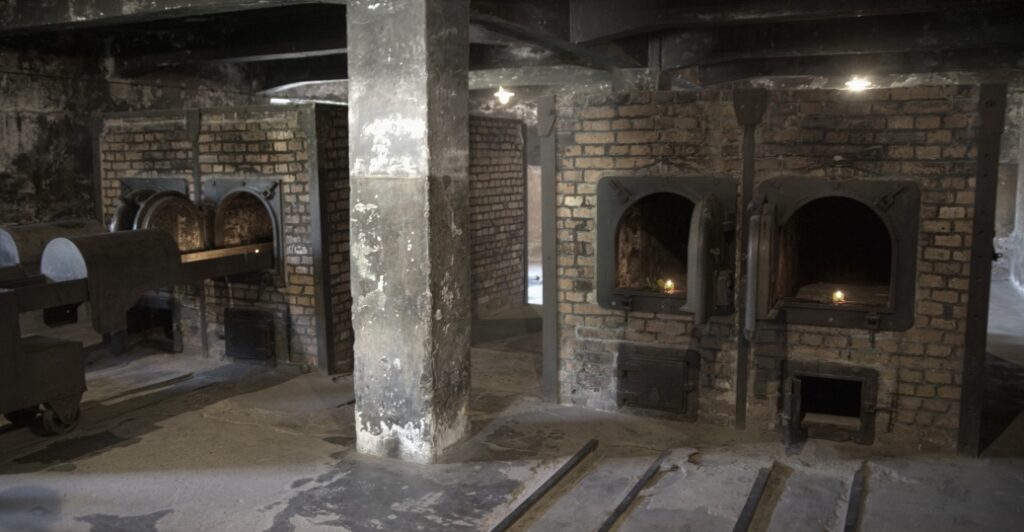
Auschwitz Crematorium 1 was built with four ovens with a capacity of 350 bodies per 24-hour day. This is the only crematorium not destroyed at Auschwitz-Birkenau.
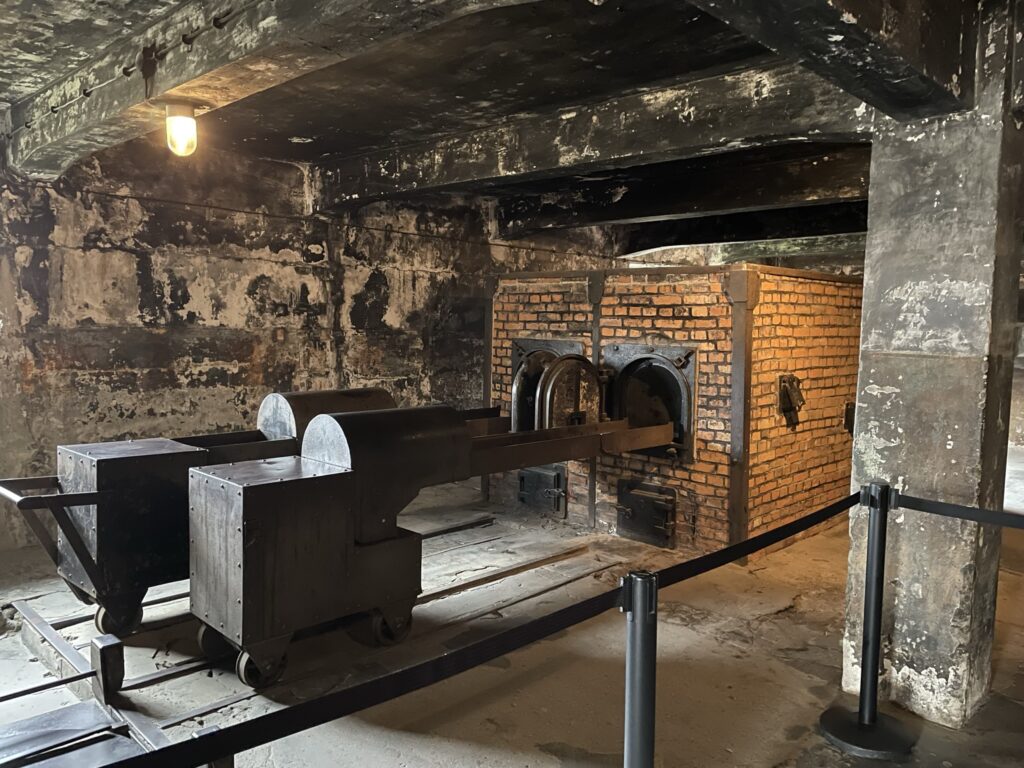
Close-up of two ovens and the track used to slide bodies in and ash out. Multiple bodies were fed into each incinerator at the same time. Ash was collected in the carts with wheels.
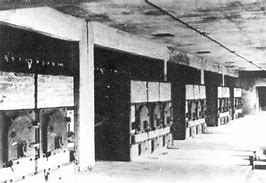
Birkenau Crematorium 2 was the second one built with fifteen ovens. This was the start of the high-volume incineration of corpses.

Picture of Crematorium 5 just prior to completion in March 1943.
(Crematorium 6 was designed in late 1943 but never built)

Bodies being burned in an outdoor burning pit. This was done when the capacity of crematoriums was exceeded.

Ruins of Crematorium 5 building. The Nazis destroyed all the gas chambers and crematoriums in Birkenau before retreating.
Only the Auschwitz 1 crematorium and one of the two gas chambers remained intact.

Ruins of Birkenau as it looks today. Only some of the wood barracks still remain.

One of many human ash pits dug in Birkenau as seen after liberation.

Over time, the human ash pits sunk, and natural ponds formed such as this one.

Human ash pond next to destroyed Crematorium 2 with memorial grave markers
The Economics of The Final Solution
Jews were forced to pay for their own deportations by train. This payment came in the form of a direct money deposit to the SS in light of the “resettlement to work in the East” myth. Adult Jews paid for full-price one-way tickets, children under 10–12 years of age paid half price, and those under four went free. Of course, any Jews without money in the ghettos got free train tickets packed in the trains under the worst of the worst conditions.
The SS forwarded part of this money to the German Transport Authority to pay the German National Railway for the transport of the Jews.
According to a report established by Reichsbahn, the receipts taken in for the deportation of Jews in the period between 1938 and 1945 totaled $35 million (1941) or $664.5 million today, factoring in inflation.
Jewish bodies were used as recyclable trash. Anything of value was seized and removed from bodies, including hair, jewelry, shoes, clothing, gold and silver dental work, dentures, prosthetics, hair brushes, shaving brushes and shavers, and much more. Jewish prisoners were forced to collect all these items in massive storage facilities at Birkenau and all other death camps.
There are stories of the fat from Jewish bodies being used to make soap. That has been debunked. The fat was used as fuel for the crematoriums and outside fire pits.

Leather luggage

Hair was collected, placed in bags, and sent to Germany to use as fiber for making cloth and felt materials for clothing, uniforms, and other purposes.
This is a storage area filled with human hair at Auschwitz-Birkenau.
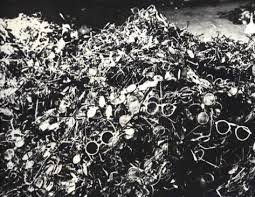
Eyeglasses
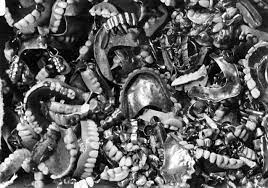
Dentures

Clothing

Prosthetics

Shoes

Wedding bands

Dental crowns and gold/silver fillings

Brushes
The German government and corporations profited handsomely from building this new industry of death.
With the cooperation of German industry and the ingenuity of the Nazi bureaucrats who managed the harvesting of material from the dead – – the entire killing operation was very profitable financially! The death camps contributed significant finances for the overall war effort and profits for the corporations involved.
The Death Industry Financial Model
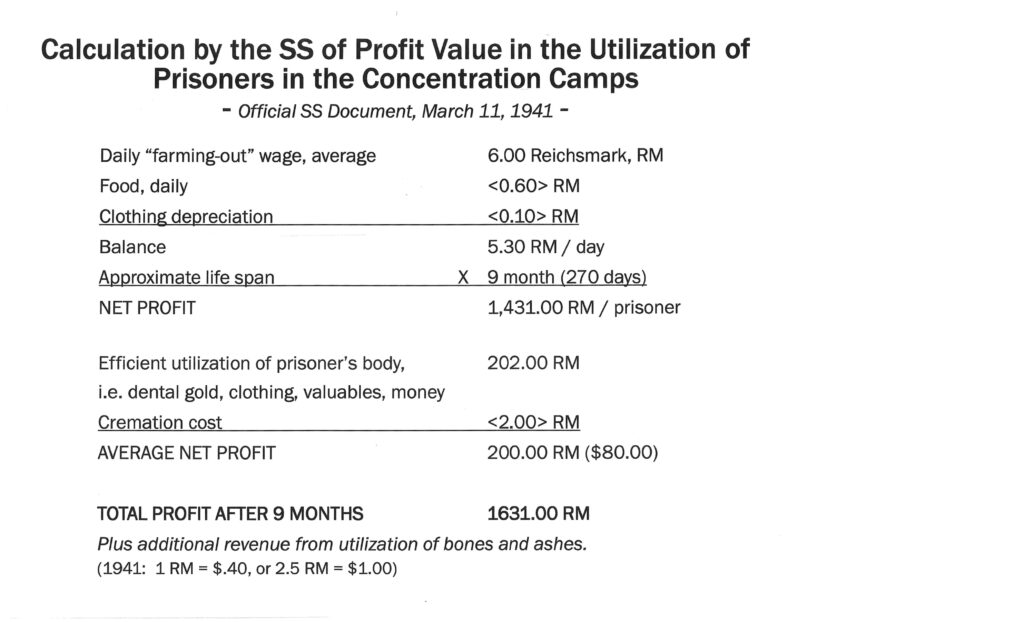
This financial model calculates the income from using Jews as slave labor to be $573 (1941) per person for nine months, their expected life span.
For those killed right at arrival, the profit was $80 (1941) per person.
Six Million Jews were killed in total, but not all in the death camps. About four million were killed in the death camps. $320,000,000 (1941) was the profit from these bodies. Adjusting for inflation, this would be $6.3 billion today.
No one knows the total value of all the personal possessions, property, businesses, art, bank accounts, investments, and more that the Germans confiscated from their Jewish victims. There is an attempted estimate of $8 billion (1942) which would be $154.4 billion, factoring in inflation.
There are claims that 1/3 of the total income of the Nazi government came from Jews.
The Industrial Greed and Profiteering To Kill Jews
While almost every industry and company in Nazi Germany was involved in the war and death camp efforts, two companies stand out as the critical enablers of the Nazi mass production death factories.
There were two critical elements of the killing process. How to kill people and how to dispose of dead bodies quickly in massive numbers with minimum labor, resources, and visibility. And how to do this at a profit.
Two companies willingly made this possible.
First, German chemical manufacturer, I.G. Farben, was the company that supplied the Zyklon B gas used in gas chambers. I.G., Farben engineers also designed the gas chambers. There was also an American connection. I.G. Farben was a financial partner with John D. Rockefeller and Standard Oil of New Jersey in a company called Standard I.G. Farben. I.G Farben developed the mass production killing process via Zyklon B and the gas chambers.
Second, J.A. Topf & Sons helped make the Holocaust possible by designing and building the crematoriums and incinerators for the Nazi concentration camps. All of the crematoriums in Auschwitz-Birkenau were designed and built by J. A Topf and sons. They even patented the process.
My Next Blog Topic
My next blog topic will be focused on the key German industries and what they contributed to make the Final Solution possible. There are American connections to several!
It is absolutely horrifying to see what the leaders and workers of major companies did to make money, knowing exactly what they were doing! And for most, there were no consequences.

